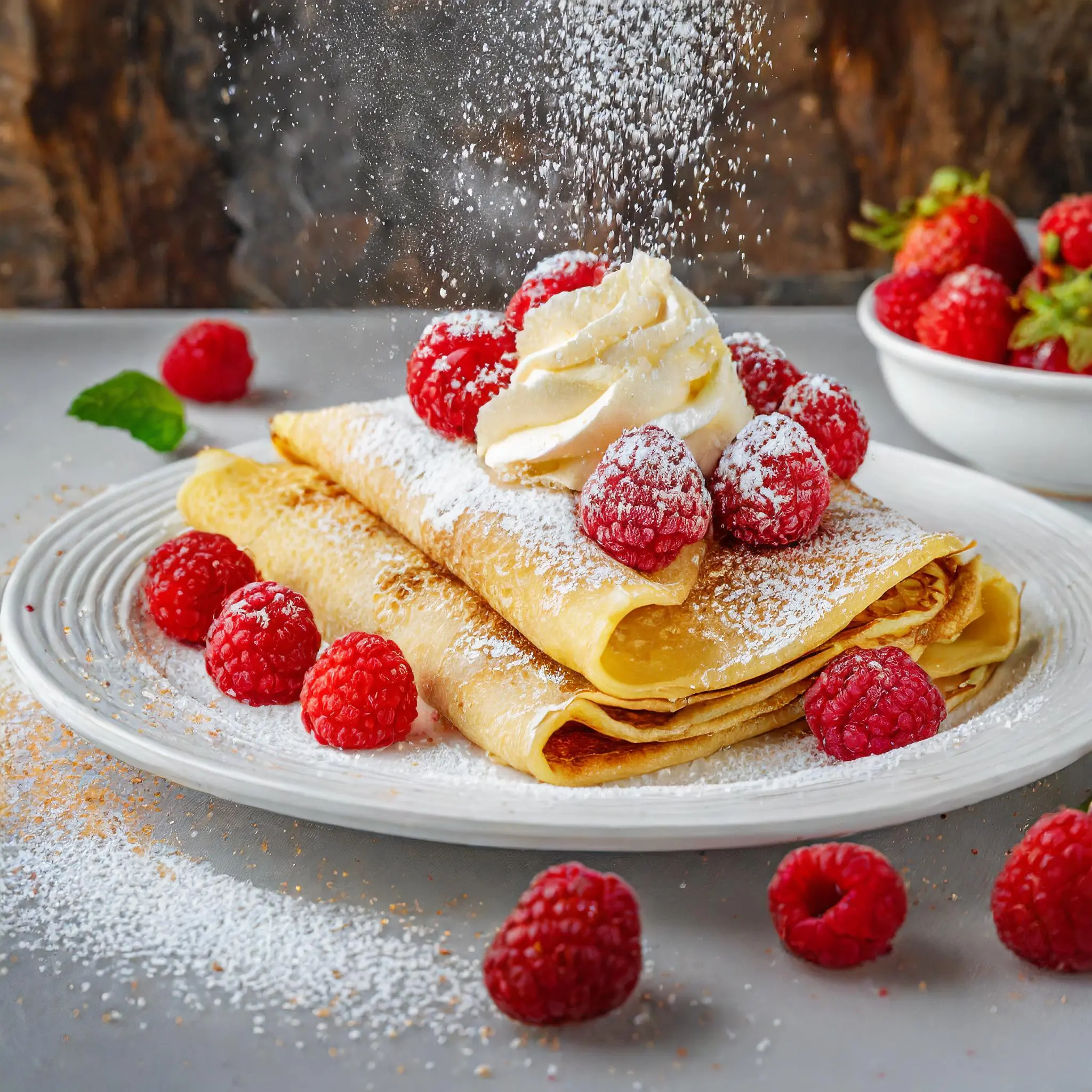Crêpes are a quintessential part of French cuisine, beloved for their versatility and simplicity. Originating in the Brittany region of France, these thin, delicate pancakes have gained worldwide fame. Whether served as a sweet dessert filled with Nutella and bananas or as a savory dish with ham and cheese, crêpes offer something for everyone.
Making crêpes at home may seem daunting, but with the right techniques and ingredients, you can achieve restaurant-quality results in your own kitchen. This guide will walk you through an authentic French crêpes recipe, tips for perfecting your technique, and ideas for creative fillings that will delight your family and guests.
Table of contents
What Are French Crêpes?
History of Crêpes
French crêpes have a rich history dating back to the 13th century in Brittany, a region in the northwest of France. Originally made from buckwheat flour, they were a staple for rural communities due to their affordability and versatility. Over time, as wheat flour became more accessible, crêpes evolved into the delicate and versatile dish we know today.
Crêpes are often associated with La Chandeleur, also known as Candlemas or Crêpes Day, celebrated on February 2nd in France. On this day, families gather to make crêpes, symbolizing prosperity and unity. Tradition holds that flipping a crêpe in the pan while holding a coin in your other hand brings good fortune for the coming year.
Difference Between Sweet and Savory French Crêpes
French crêpes are typically categorized into two types: sweet crêpes (crêpes sucrées) and savory crêpes (crêpes salées).
- Sweet Crêpes: Made with all-purpose flour and slightly sweetened with sugar or vanilla extract, these crêpes are ideal for desserts or breakfast. Popular toppings include Nutella, fruit, whipped cream, or a dusting of powdered sugar.
- Savory Crêpes: Also known as galettes when made with buckwheat flour, savory crêpes are a hearty option for lunch or dinner. They are traditionally filled with ingredients like ham, cheese, eggs, and vegetables.
The beauty of crêpes lies in their adaptability. Sweet or savory, they serve as a blank canvas for endless culinary creativity.
Ingredients for French Crêpes
Essential Ingredients
Creating authentic French crêpes requires only a handful of basic ingredients:
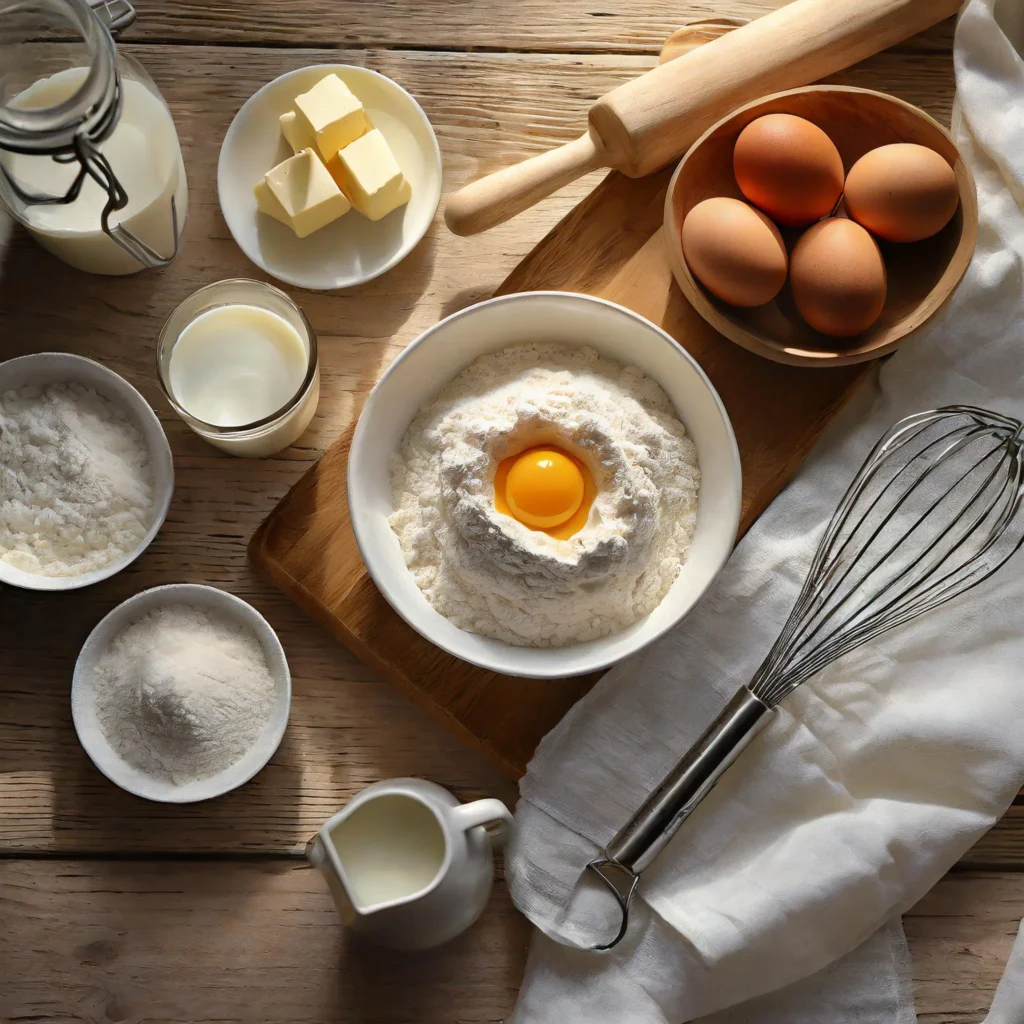
- Flour: All-purpose flour for sweet crêpes; buckwheat flour for savory versions.
- Eggs: Provide structure and richness to the batter.
- Milk: Adds moisture and ensures a smooth consistency.
- Butter: For a subtle, nutty flavor and a nonstick surface.
- Salt: Balances the flavors.
- Optional Vanilla or Sugar: Enhances sweetness for dessert crêpes.
Optional Add-Ons for Flavor Variations
To add a personal touch, consider incorporating:
- Lemon zest for a citrusy twist.
- Cocoa powder for chocolate crêpes.
- Almond or rum extract for a unique aroma.
Importance of Fresh Ingredients
Using fresh, high-quality ingredients significantly impacts the final result. Fresh milk and eggs create a batter with better texture, while fresh fruits and toppings elevate the overall experience.
Step-by-Step French crêpes Recipe
Mastering the art of crêpe-making requires attention to detail and a bit of practice. Follow this step-by-step guide to create authentic, golden-brown crêpes every time.
1. Preparing the Batter
The foundation of great crêpes is a well-prepared batter. Here’s how to make it:
Ingredients (for about 10-12 crêpes):
- 1 cup (125g) all-purpose flour
- 2 large eggs
- 1 1/2 cups (375ml) milk
- 2 tablespoons (30g) melted butter (plus extra for greasing the pan)
- 1/4 teaspoon salt
- Optional: 1 tablespoon sugar and 1 teaspoon vanilla extract (for sweet crêpes)
Instructions:
- Sift the Flour: In a large mixing bowl, sift the flour to avoid lumps.
- Add Eggs: Create a well in the center of the flour and crack in the eggs.
- Mix Gradually: Slowly whisk the eggs into the flour, incorporating a bit of milk at a time. This prevents clumps from forming.
- Add Butter and Flavorings: Stir in the melted butter, salt, and optional sugar or vanilla extract.
- Achieve Smooth Consistency: The batter should be silky and pourable, similar to heavy cream.
Pro Tip: If lumps persist, strain the batter through a fine mesh sieve.
2. Resting the Batter
Resting the batter is a crucial but often overlooked step. Allow the batter to sit for at least 30 minutes at room temperature. This rest period:
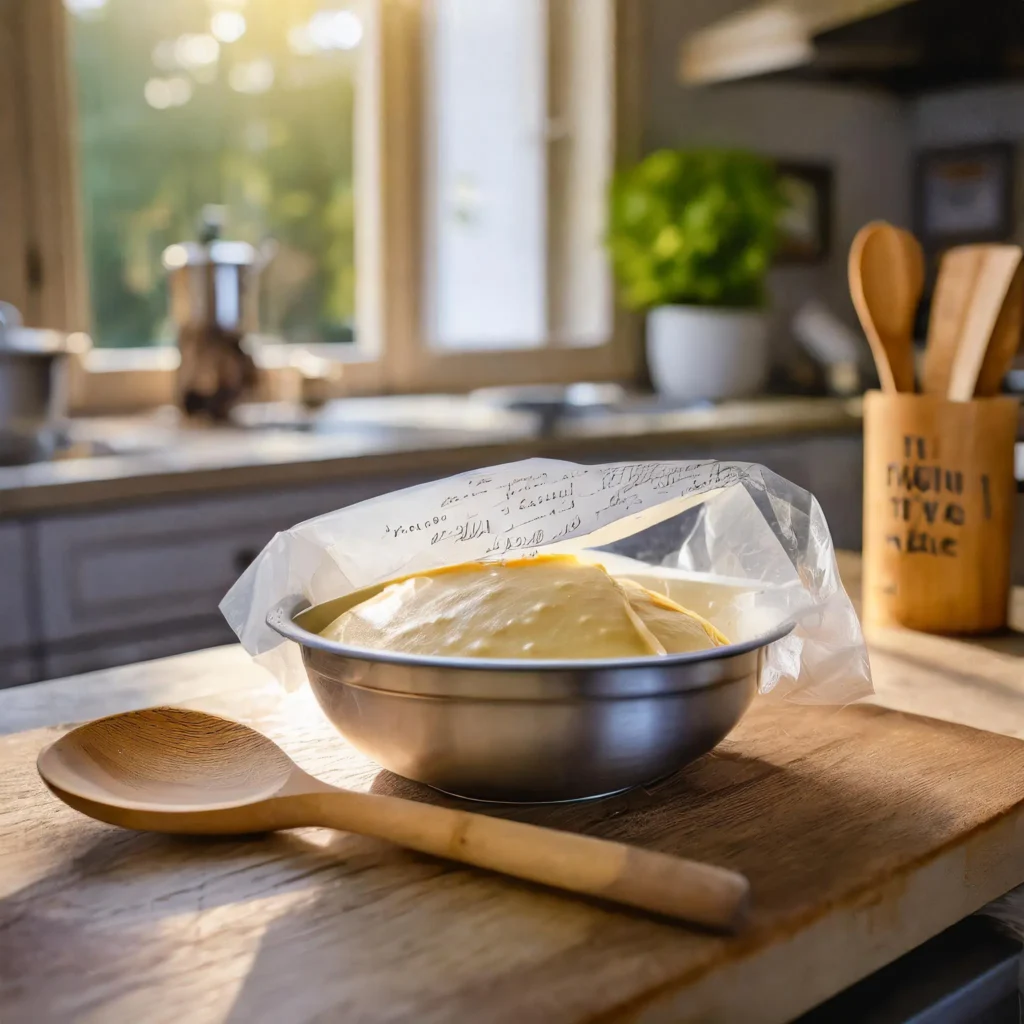
- Hydrates the Flour: Ensures a smooth texture.
- Relaxes Gluten: Prevents tough or rubbery crêpes.
If you’re prepping ahead, cover the batter and refrigerate it for up to 24 hours.
3. Cooking Techniques for Perfect French Crêpes
To achieve those paper-thin, golden crêpes, follow these cooking steps:
- Heat the Pan: Use a nonstick or crêpe pan over medium heat. Once hot, add a small amount of butter and swirl to coat the surface.
- Pour and Swirl: Pour 1/4 cup of batter into the pan, tilting it in a circular motion to spread the batter thinly and evenly.
- Cook Until Set: After about 1-2 minutes, the edges of the crêpe will start to lift. Flip it with a spatula or your fingers.
- Cook the Other Side: Cook for another 30 seconds to 1 minute. The second side will cook faster.
- Stack and Cover: Transfer to a plate and cover with a clean kitchen towel to keep warm.
Pro Tip: The first crêpe is often imperfect. Treat it as a test for the pan’s heat and batter consistency.
4. Tools You’ll Need
To simplify the process, gather these tools:
- Nonstick Pan or Crêpe Pan: Ensures easy flipping and even cooking.
- Ladle or Measuring Cup: For consistent portions.
- Rubber Spatula: For flipping delicate crêpes.
- Whisk: To mix the batter thoroughly.
With these techniques, you’re well on your way to creating crêpes with restaurant-quality finesse. In the next part, we’ll cover tips to perfect your crêpes and avoid common mistakes.
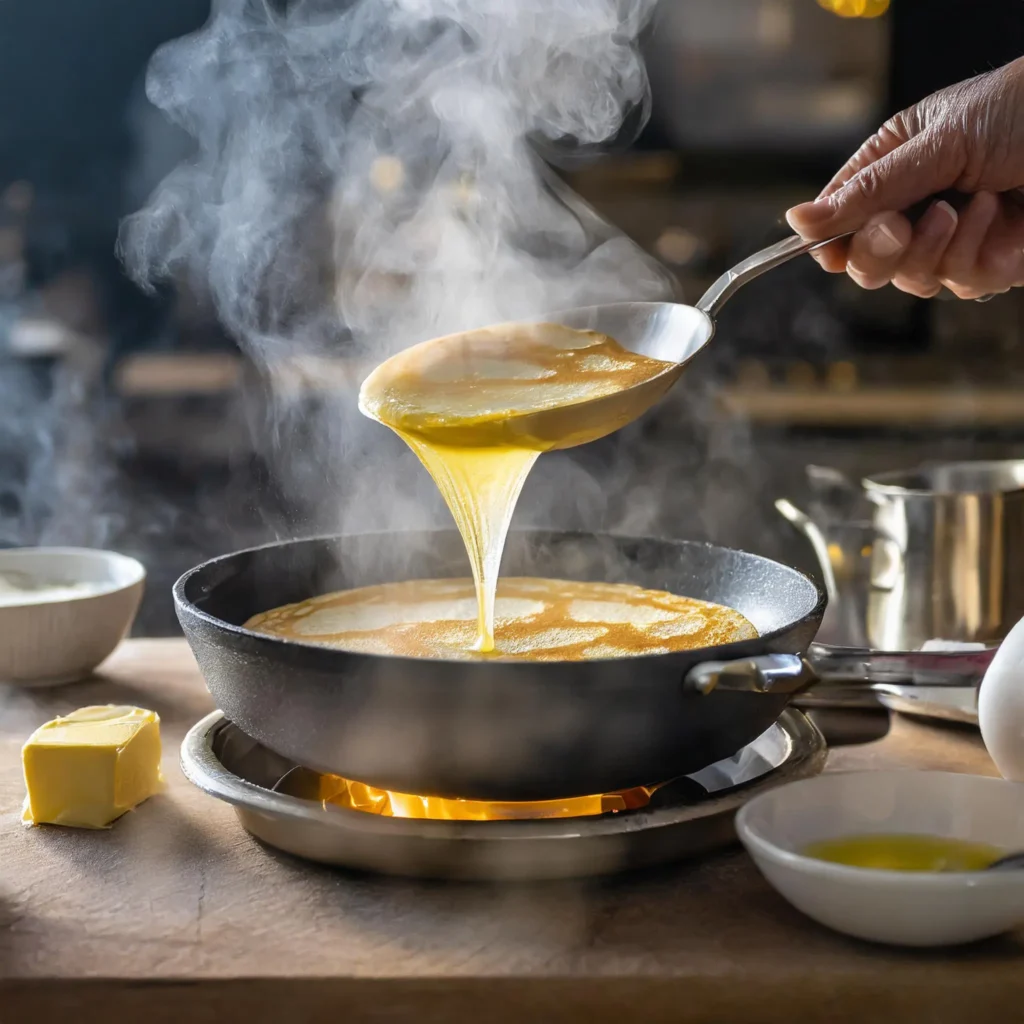
Tips for Perfect French Crêpes
Making flawless crêpes requires practice, but these expert tips can help you avoid common pitfalls and improve your results.
1. Common Mistakes to Avoid
- Skipping the Batter Rest: This is essential for smooth, elastic crêpes. Rushing this step often results in fragile or rubbery crêpes.
- Overheating the Pan: A pan that’s too hot can cause the batter to cook unevenly or stick. Always start with medium heat and adjust as needed.
- Too Much Batter: Adding too much batter makes crêpes thick and hard to fold. Stick to about 1/4 cup per crêpe.
- Flipping Too Early: Let the edges lift naturally before attempting to flip the crêpe. This ensures the surface has cooked enough to handle the turn.
2. How to Flip French Crêpes Like a Pro
Flipping crêpes may seem tricky at first, but here’s how to do it with ease:
- Use a Spatula: Gently loosen the edges of the crêpe all around the pan.
- Practice Wrist Motion: If flipping with your hand, slide the crêpe partially out of the pan, grab the edge, and quickly flip it back onto the pan.
- Use a Nonstick Pan: The right pan makes all the difference, minimizing sticking and breaking.
- Confidence Is Key: If you’re nervous, start with smaller crêpes to practice flipping.
3. Maintaining Consistency in Thickness
For evenly thin crêpes, follow these tips:
- Swirl Quickly: The moment you pour the batter into the pan, tilt and swirl the pan in a circular motion to coat the surface evenly.
- Measure Your Batter: Use the same amount of batter for each crêpe to maintain consistency.
- Adjust as Needed: If the batter thickens while resting, add a splash of milk and whisk to restore its smooth, pourable consistency.
4. Troubleshooting Tips
- Tearing Crêpes: Batter that’s too thin or a pan that’s too cool can cause tears. Thicken the batter slightly and ensure the pan is evenly heated.
- Browning Unevenly: Uneven heat distribution often leads to patchy browning. Use a high-quality pan for uniform results.
- Sticky Crêpes: A lack of butter or oil in the pan can cause sticking. Always grease the pan lightly before each crêpe.
5. Pro Techniques to Elevate Your Crêpes
- Double Cook Method: Cook French crêpes on the first side until fully golden, then finish the second side quickly for a lightly crispy texture.
- Stack and Warm: To serve crêpes warm, stack them with parchment paper between each one and cover them with foil in a low oven (around 200°F/90°C).
- Add Flavor Directly: Sprinkle sugar or spread fillings on the crêpe while it’s still warm in the pan for melted, infused flavors.
With these tips, your crêpes will turn out perfect every time! Next, we’ll dive into a variety of sweet and savory filling ideas to inspire your creations.
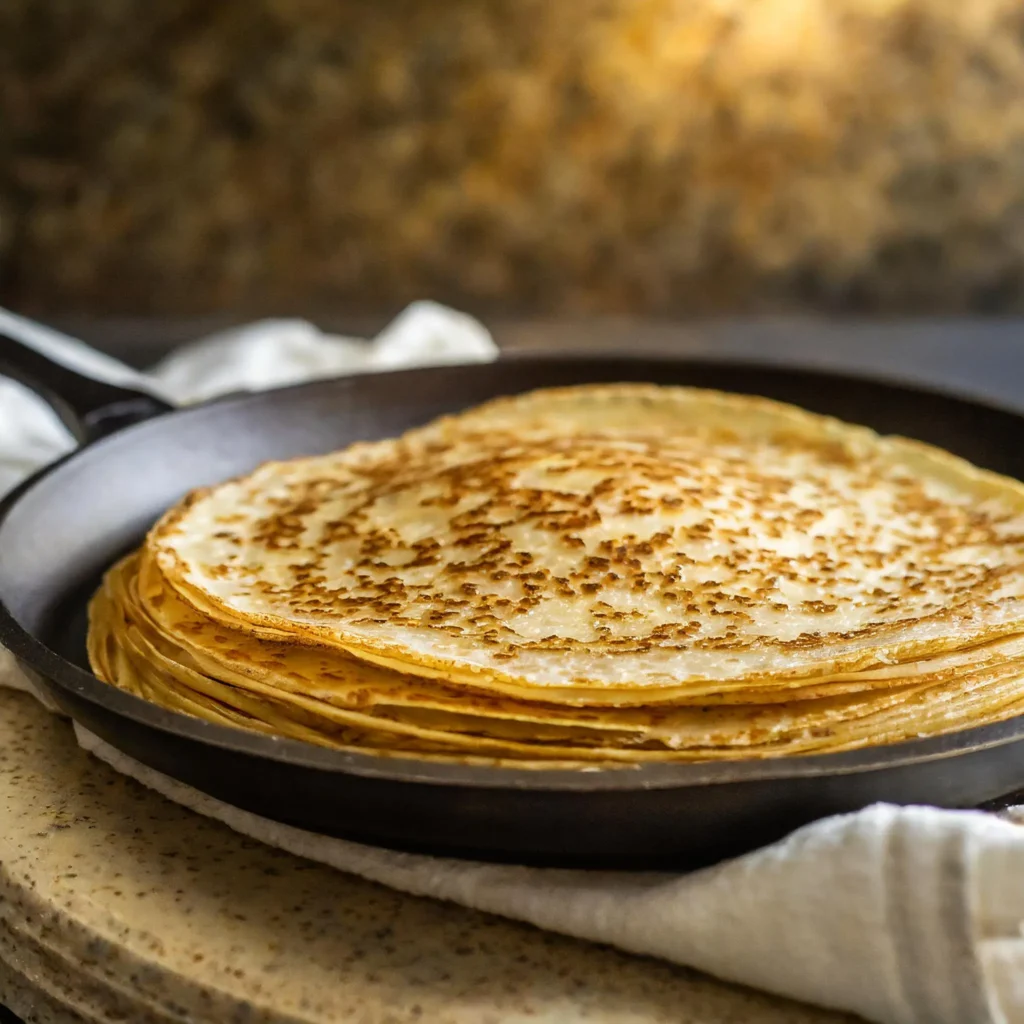
Part 5: Delicious Crêpe Fillings
One of the most exciting aspects of making crêpes is experimenting with a wide range of fillings. Whether you prefer something sweet for dessert or savory for a satisfying meal, crêpes offer endless possibilities.
Sweet Fillings
Sweet French crêpes are a favorite for breakfast, brunch, or dessert. Here are some classic and creative ideas:
- Classic Nutella: Spread a generous layer of Nutella over the crêpe and fold it into quarters. Top with powdered sugar for a quick and indulgent treat.
- Fresh Fruits and Cream: Fill the crêpe with strawberries, bananas, or blueberries, and add a dollop of whipped cream. For extra flair, drizzle with chocolate sauce or honey.
- Lemon and Sugar: A simple yet timeless filling, sprinkle granulated sugar over the crêpe and squeeze fresh lemon juice on top. Roll it up and enjoy!
- Caramelized Apples: Sauté apple slices with butter, brown sugar, and cinnamon, then spoon the mixture onto the crêpe. Pair with a scoop of vanilla ice cream for a decadent dessert.
- Chocolate Ganache: Spread warm, melted chocolate ganache inside the crêpe and fold it into a triangle. Garnish with a sprinkle of cocoa powder or shaved chocolate.
Savory Fillings
Savory crêpes, often made with buckwheat flour, make for a hearty and satisfying meal. Here are some filling suggestions:
- Ham and Cheese: Fill the crêpe with slices of ham and grated Gruyère or Swiss cheese. Fold it and heat in the pan until the cheese melts.
- Spinach and Ricotta: Combine cooked spinach with ricotta cheese, garlic, and nutmeg for a creamy filling. Add a pinch of Parmesan for extra flavor.
- Smoked Salmon and Cream Cheese: Spread cream cheese on the crêpe, layer with smoked salmon, and garnish with capers and dill.
- Mushroom and Onion: Sauté mushrooms and onions with butter, thyme, and a splash of cream. Spoon the mixture into the crêpe and serve warm.
- Egg, Bacon, and Cheese: Crack an egg directly onto the crêpe while it cooks in the pan, add crispy bacon and cheese, and fold it into a square shape.
Seasonal and Gourmet Ideas
For a more elevated experience, try these unique combinations:
- Fig and Goat Cheese: Spread goat cheese on the French Crêpes and add fresh figs, walnuts, and a drizzle of honey.
- Pumpkin Spice: Fill the crêpe with a mixture of pumpkin puree, cream cheese, and spices like cinnamon and nutmeg.
- Berry Compote: Make a quick compote by simmering berries with sugar and lemon juice. Serve warm as a filling or topping.
Presentation Ideas
How you serve your crêpes can make them even more appealing:
- Folding Styles: Experiment with triangles, rolls, or even stacking crêpes into a layered cake.
- Garnishes: Add powdered sugar, fresh mint leaves, or edible flowers for a professional touch.
- Drinks Pairing: Serve sweet crêpes with coffee or tea and savory crêpes with cider or dry white wine.
With these filling ideas, you’ll never run out of inspiration. In the next section, we’ll explore creative crêpe variations, including gluten-free and vegan options.
Variations, FAQs, and Conclusion
Variations of French Crêpes
Crêpes are wonderfully adaptable, allowing you to cater to dietary preferences and experiment with different textures and flavors. Here are some popular variations:
1. Gluten-Free Crêpes
For gluten-free crêpes, replace regular flour with gluten-free all-purpose flour or other substitutes like rice flour or almond flour. Alternatively, opt for buckwheat flour, which is naturally gluten-free and ideal for savory galettes.
Recipe Adjustments:
- Increase the milk slightly if the batter feels too thick.
- Ensure the pan is well-greased to prevent sticking.
2. Vegan Crêpes
Vegan crêpes eliminate eggs and dairy while maintaining their characteristic thin and pliable texture.
Ingredients for Vegan Crêpes:
- 1 cup (125g) all-purpose flour
- 1 1/2 cups (375ml) plant-based milk (almond, soy, or oat milk)
- 2 tablespoons vegetable oil or melted coconut oil
- A pinch of salt and optional sugar for sweet crêpes
3. Buckwheat French Crêpes (Galettes)
Buckwheat crêpes are darker and slightly nutty in flavor, traditionally used for savory dishes. They’re perfect for fillings like ham, cheese, and eggs.
Ingredients:
- 1 cup (125g) buckwheat flour
- 1 1/2 cups (375ml) water or milk
- 1 large egg
- A pinch of salt
Pro Tip: Let buckwheat batter rest longer (1-2 hours) for a better texture.
Frequently Asked Questions (FAQs)
1. What’s the difference between French Crêpes and pancakes?
Crêpes are thinner and lack leavening agents like baking powder, making them flat and delicate compared to the fluffy texture of pancakes.
2. Can I make crêpes without a nonstick pan?
Yes, but it’s more challenging. If using a stainless-steel pan, grease it generously with butter and ensure it’s well-heated before pouring the batter.
3. How do I prevent crêpes from tearing?
Rest the batter to strengthen its structure and use a gentle flipping technique. Avoid making the crêpes too thin.
4. Why should I rest the batter?
Resting allows the gluten to relax and the flour to hydrate, resulting in smoother, more elastic crêpes.
5. How long can French Crêpes last?
Crêpes can be stored in the refrigerator for up to 2 days. To freeze, stack them with parchment paper in between, wrap tightly, and store for up to 2 months.
6. Can I use regular flour for gluten-free crêpes?
No, regular flour contains gluten. Use a certified gluten-free flour or buckwheat flour for gluten-free options.
Conclusion

Crêpes are a timeless culinary delight that can be tailored to suit any taste or occasion. From sweet breakfast treats to hearty dinner options, they are as versatile as they are delicious. With this guide, you now have all the tools to make perfect crêpes, along with creative ideas to elevate your filling and presentation.
Whether you’re flipping French Crêpes for the first time or refining your technique, enjoy the process and let your creativity shine. Bon appétit! see similar article Eggless Pancakes a Delicious Breakfast

French Crêpes
Equipment
- Nonstick Pan
- Whisk
- Ladle or Measuring Cup
- Rubber Spatula
Ingredients
Crêpe Batter
- 1 cup all-purpose flour (125g)
- 2 large eggs
- 1 1/2 cups milk (375ml)
- 2 tbsp melted butter (plus extra for greasing the pan)
- 1/4 tsp salt
- 1 tbsp sugar (optional, for sweet crêpes)
- 1 tsp vanilla extract (optional, for sweet crêpes)
Instructions
- Sift the flour into a large mixing bowl to avoid lumps.
- Create a well in the center of the flour and crack in the eggs.
- Slowly whisk the eggs into the flour while incorporating a bit of milk at a time to prevent lumps.
- Stir in the melted butter, salt, and optional sugar or vanilla extract.
- Mix until the batter is smooth and has the consistency of heavy cream. If lumps persist, strain through a fine mesh sieve.
- Let the batter rest for at least 30 minutes at room temperature to ensure a smooth texture.
- Heat a nonstick or crêpe pan over medium heat and lightly grease with butter.
- Pour 1/4 cup of batter into the pan, tilting in a circular motion to spread the batter evenly.
- Cook for 1-2 minutes until the edges lift and the bottom is golden brown, then flip using a spatula.
- Cook for another 30 seconds to 1 minute, then transfer to a plate and cover with a clean kitchen towel to keep warm.
- Repeat with the remaining batter, greasing the pan lightly as needed.

